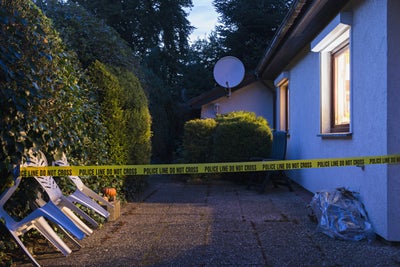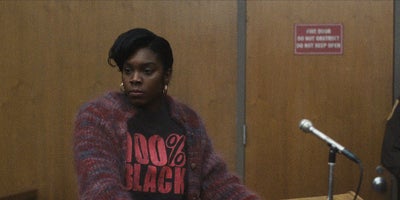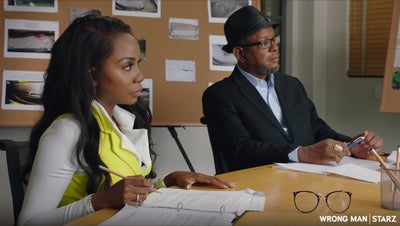
True crime is a phenomenon. From television shows and films to podcasts and publications, stories exploring the details of real crimes, especially cases of missing and murdered people, are part of one of the fastest growing genres. Some believe watching or listening to true crime storytelling provides an opportunity to learn about the successes and failures of our criminal justice system, raise awareness around little known cases and potentially aid in the acquittal of wrongfully convicted individuals. Others are critical and say that true crime content can skew how we think about the justice system, perpetuate myths about the typical victims of violent crimes or convince viewers that their internet sleuthing can help solve a case.
“I think true crime podcasts, at least the good ones, kind of give an insight into human nature. In a way it’s kind of unbelievable that people can do the things that are being described,” Norris Francois Jr., a filmmaker, tells ESSENCE.
The self-described podcast enthusiast says that he has listened to tens of thousands of hours of podcasts, including true crime ones. He understands both the praise and criticism of them.
“Some just tell you the story. Some of them advocate for causes at the end, they tell you to look into it, donate to funds that support and get lawyers for people who may be wrongly convicted. So, I learn a lot in that regard,” Francois says. “However, I agree that there are negative aspects in general. I listen to a good range and some of them you can really hear that the tone is exploitative,” he added, noting that those are often the most popular true crime podcasts.
Those critical of the content say it can desensitizes viewers to violent crimes and murders to the point where these stories are simply viewed as “entertainment” instead of real life tragedies. This is especially true in the cases of missing and murdered Black people.
“We know from the data that they’re [Black women] underrepresented and when they are represented, it’s sometimes victim blaming, that we say, see, why did she go home with such and such? Or why were they out at this time of the day,” says Dr. Apryl Alexander, Associate Professor in the Department of Public Health Sciences at UNC Charlotte.
The death of Lauren Smith-Fields last December didn’t receive much media coverage until several weeks after her death. Smith-Fields, a 23-year-old Black woman, was found dead in her Connecticut apartment after meeting with an older white man she met on the dating app Bumble. Once her story gained national attention, there were concerns about the way it was being framed in the press, the police investigation and some online reactions via true crime projects.
Some social media users expressed their displeasure of her dating outside of her race, while others implied that she was involved in sex work and thus brought violence upon herself. The popular nature of true crime may impact how comfortable people feel chiming in on the tragic details and trying to piece together the story themselves.
“It’s like a lot of victim blaming content. Instead of ‘Let’s focus on the horrific event,’ it’s ‘Let’s focus on finding the person who caused harm.’ So Black women and girls are just not treated equitably in some of these cases, in general, and then in the true crime genre,” Dr. Alexander explains.
**
Between 2003 and 2004, serial killer Larry Bright lured and murdered at least eight Black in Peoria, Illinois. Some women were strangled and their bodies dumped in rural areas, others he burned and buried in his backyard.
Pinnacle’s 2010 book Bonecrusher is about Bright and his crimes against the women—and it upset many of their families. The front cover of the book depicts the murderer and inside the book, there are photographs of various crime scenes and murder artifacts, such as bone fragments from some of the victims.
As author Terrion L. Williamson points out in a 2021 article, there was information included in the book from the murder investigation that was not accessible family and community members. Terrion wrote, “the book caused some feelings of betrayal and outrage in the community, as very few of the victims’ family members had even heard of or spoken with the author prior to its release.”
Williamson, an Associate professor of African American & African Studies at the University of Minnesota, added that Carmea Erving, the oldest daughter of Brenda Erving, the last woman killed by Bright said to her , “It’s not right. How you know I want you to tell my story?”
***
From 2018 to 2021, the number of documentary series on streaming services grew 63 percent and true crime was the largest segment of that, according to data from media tracking company Parrot Analytics. Also, in one year, the average true crime consumer tunes into approximately 84 episodes of true crime TV, 44 chapters of true crime books, 34 episodes of true crime podcasts and 20 true crime movies, according to a survey by Super Summary. The interest is only growing.
As a clinical and forensic psychologist, Dr. Alexander says that the growth of the true crime genre is a combination of the fascination that people have about criminal behavior and why it occurs, coupled with the ease of access to these stories online via streaming services and social media. However, she says it’s important to remember that this is not just content that should be viewed for “entertainment”, but the retelling of real events with real victims.
“I always think of people who say, ‘oh, I’m so obsessed with studying serial killers and finding out all about them.’ I always say they had real actual victims, victims that could have been your friend, family member, whomever,” she says.
In September, Netflix released Monster: The Jeffrey Dahmer Story, a series about serial killer Jeffrey Dahmer. Between 1978 and 1991, Dahmer murdered and dismembered 17 men and boys, the majority of whom were queer and Black or Brown. The series broke Netflix’s worldwide record for a series debut in its opening week, but it also received a great deal of backlash, primarily being accused of profiting off of the trauma endured by the many Black and queer people Dahmer murdered and the families they left behind.
“We’re all one traumatic event away from the worst day of your life being reduced to your neighbor’s favorite binge show,” Eric Perry, a relative of Dahmer victim Errol Lindsey, told the Los Angeles Times. “And most importantly, if you’re going to create something that uses real-world people and experiences, you should at minimum contact those people out of respect,” he also said.
Lindsey’s sister, Rita Isbell, whose courtroom victim impact statement was portrayed in the series, has also criticized the streaming platform for failing to contact the families of the victims before producing a show content based on their pain.
Read our op-ed, Netflix’s ‘Monster: The Jeffrey Dahmer Story’ Deserves The Backlash
Civil and criminal defense attorney Sue-Ann Robinson says that true crime content and the fans of these shows can help or hinder legal investigations. “I think true crime shows depending on how they’re done can give the public more information. Or they can actually desensitize the public, if it’s just kind of done for shock value,” said Robinson, who served as the legal expert on Season 1 and 2 of the STARZ’s investigative docu-series Wrong Man.
As a member of the team, Robinson re-investigated cases in which incarcerated defendants insisted on their innocence. Notably two defendants from the series were released from prison based on new evidence exposed by the series investigation.
“True Crime fans can be a shield and a sword because if they’re doing the right things, asking the right questions and bringing awareness to a case that’s not getting light shed upon it, then it’s great. But if they’re doing things that are negative like spreading false information or taking police attention away from things that they do need to investigate, then it’s a problem,” explains Robinson.
True crime fan Morgan Angelique Owens says she watches shows like The First 48 and Forensic Files because they do focus on the stories of the victims and their families rather than the perpetrator.
“What got me interested is actually that I minored in criminology. I always wanted to go to law school, growing up in the inner city, and see how I could make a difference, especially in the criminal justice field,” she shares with ESSENCE. “My dad was actually the Hamilton County Coroner when I was in college. I got to do my internship at his office and so that was an interesting experience that made me even more invested in this. He was actually on a couple episodes of The First 48 here in Cincinnati,” she adds.
For Owens, now an entrepreneur working in media, true crime content is an important tool that sheds light on little known cases, which she says is especially critical for stories of missing or murdered Black women which don’t always get the attention they deserve.
“People’s lives, especially Black women who have been missing or had a crime committed against them, these stories need to be told despite criticism because how are we going to know about them, and how are we going to remember them?” says Owens.
She notes that she can’t recall seeing a recent episode of her favorite true crime shows that highlighted the stories of Black women. Robinson says this is often the case because Black women are rarely seen as victims of crime. Due to this the defense attorney and former prosecutor believes it’s imperative that this perception changes.
“I think Black women are the canary in the coal mine for these issues. We’re right at the intersection of race and gender. So we’re the most vulnerable, but we’re also the ones that are on the frontlines of needing that visibility, needing our cases to be more heightened awareness around that because we’re at the intersection,” said Robinson.
“The more that we can have stories that explain our vulnerability, the fact that we are the canaries in the coal mine, the fact that it’s not a Black woman, missing issue or murdered issue, it’s a person missing or murdered and that it should be an issue for everyone,” she says.
Source: Read Full Article


